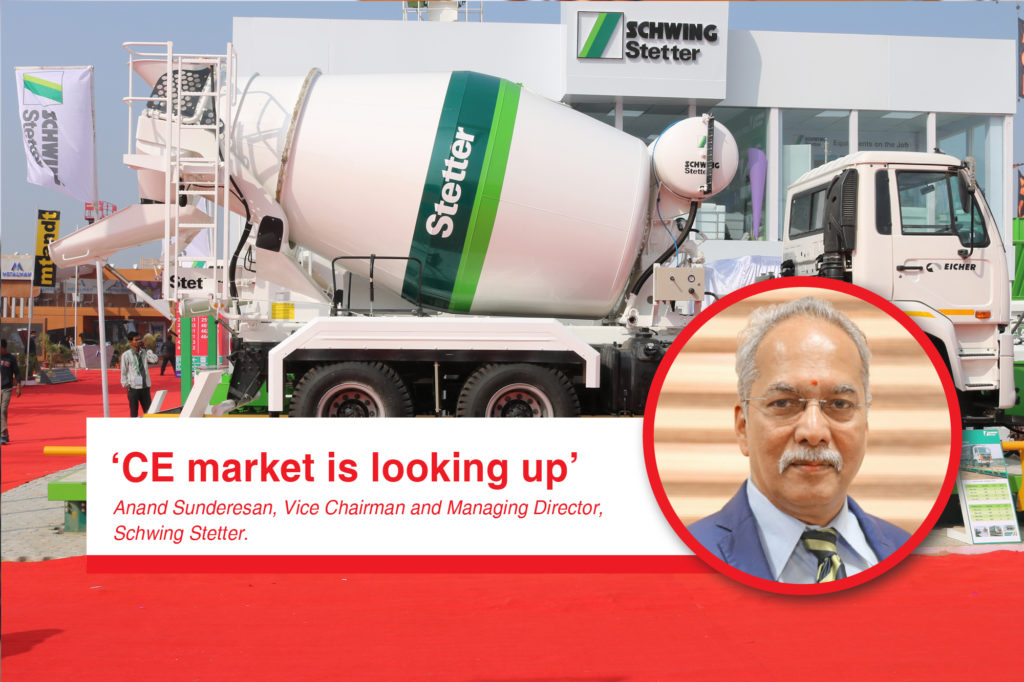Automation and use of robotics will play a crucial role in increasing efficiency and productivity in manufacturing construction equipment.
Anand Sunderesan, Vice Chairman and Managing Director, Schwing Stetter
Automation is likely to play a major role in construction equipment market in future with Internet of Things (IoT) taking the lead. Manufacturing construction equipment is expected to witness use of robotics, says Anand Sundaresan, Vice Chairman and Managing Director, Schwing Stetter India and Chairman, Infrastructure Equipment Skill Council, in an interaction with Arpita Saxena.
Please share your outlook on the construction equipment (CE) market in India?
The industry has been doing quite well since 2016 with over 15 per cent growth as compared to 2015. In 2017 the offtake was over 82,000 units which was higher compared to the previous highest offtake of 74,000 to 75,000 in 2011. The first half of 2018 was good, barring July and August, that witnessed slowdown due to monsoon and events like transport strike and floods in Kerala and Karnataka. So, while these two three months could be an issue, we are confident that going forward, things are likely to be better for the construction equipment market.
What is your contribution to the country’s CE industry?
Schwing Stetter equipment were being used even before the company was started in India. Then, Mechanisation of concreting was in its infant stage. We spent special attention to trigger mechanisation in a big way. Before we started the company in 1999, Schwing Stetter equipment found its way into India through a reputed agency and our Parent, Schwing GmBH were very cooperative and we could take many prospective buyers to their plants and show them the difference between conventional and state of the art methods and also demonstrate the intangible and tangible benefits. We also started conducting seminars across the country, visited big corporations like steel plants, municipal corporations, project authorities, policy makers etc. and started demonstrating the advantages and usages of modern equipment with respect to quality, consistency etc. on use of RMC equipment. This spurred the real interest in 1995 and in 1999 -2000 when we started the company in India, mechanisation of this product started. Thus, we played a very important role in mechanising the concreting process. However, still there is a long way to go, since only about 12 per cent of the total cement produced in India goes into RMC equipment in concrete construction as against 60 per cent to 70 per cent in developed countries.
How do you plan to cater to the growing demand in the CE market?
When you look at the construction market, the road sector is doing well. There are two kinds of roads – concrete roads and asphalt roads This will bring huge demand for concreting equipment, road making machinery like asphalt plant. Loaders, pavers etc. besides some of the earth moving equipment like backhoe loaders, motor graders, wheel loaders, excavators etc. Railways sector are also witnessing growth which would lead to surge in demand for construction equipment. India is the only country in the world where so many metro rail projects are under construction in different cities. This also triggers huge demand for concreting equipment, piling machines, higher capacity cranes, tunnelling equipment etc. We are continuously monitoring the growth areas and introducing new products and increasing the capacity to meet the growing demand. Considering the future opportunities, we are going for further expansion and increasing the number of sales, service and training centres.
What is the biggest challenge you’ve faced in manufacturing concrete equipment in terms of technology?
Technology is not really a challenge. Most of the construction equipment manufacturers of India are subsidiaries of multinational companies with seamless access to technology through their respective parent companies. Similarly, the equipment being supplied by Schwing Stetter India are always based on state of the art technology similar to ones being used in developed countries, though the capacity in some products may be smaller. There is a regular interaction between the design department in India and that of the parent company to keep updated on latest developments. India being a price sensitive market initial investment on the equipment plays a very important role in decision making process of the customer. However, things are fast changing as the penalties for delay in executing the project are very high. I view of this, most companies tend to go for high productive high performance latest equipment.
Going ahead, what further implication will automation have on the CE industry?
Automation and use of robotics will play a very important role in increasing efficiency and productivity in manufacture of construction equipment. Most of the manufacturers have already implemented or in the process of implementing mechanization to meet the growing need for quality.
Intensive usage of electronics and automation in the equipment is also seen. We are moving towards the next level of automation with IoT being the focus by most of the customers. In fact, Schwing Stetter India is able to offer IoT solutions in all major equipment.
Cookie Consent
We use cookies to personalize your experience. By continuing to visit this website you agree to our Terms & Conditions, Privacy Policy and Cookie Policy.















